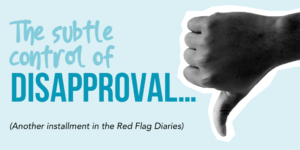This writing is now available as a podcast episode!
I’ve been quiet lately. My last writing just over a month ago.
My Fall has been a series of loops and WTFs I didn’t see coming, traveling to teach, flakes, and stress up the wazoo. I’m WAY behind on everything.
I’ve TRIED to keep up with my messages as I can. I have over 91 I’ve not yet read.
BUT… there were I few I worked very hard to stay on top of, and that is those from people who were in my classes over the last few months, because I said they could follow up with me with questions.
Today’s writing is inspired by one of those questions.
In my class on protocol, I talk about a conflict resolution protocol I have in place in my relationships.
It’s based on a joke I make about communication:
“I command you to stop being upset!”
Which, perhaps some people are domly enough to be able to pull off, but I have yet to find a way to out-dominate our humanity, and frankly, I don’t want to try (or at least rarely).
So, I sometimes find myself with Pet (and others) in a circular ‘discussion,’ where we just keep saying the same things to each other in turns, gradually ratcheting up the volume and tone.
Just me?
Yeah. I thought so. I’ll keep sharing this anyway.
smiles
So, as the dominant in my relationships, I find it useless to continue these patterns when I see them happening, and I’ve created a protocol that works for us, to break the pattern, diffuse the issue, and to make sure that we cover the topic(s) and resolve them.
Someone from my protocol class at CCFF (Coastal Carolina Fetish Fair) asked if I had this written, since they wanted to share this with their partner, so here goes.
NOTE: I am not one to stand on protocol in every day situations, so I’m called by my name most often. I rarely ‘force’ the issue.
NOTE: I am not one to stand on protocol in every day situations, so I’m called by my name most often. I rarely ‘force’ the issue.
Audio recording for tone of voice and inflections:
ARGUMENT ENSUES
It’s going nowhere. Voices are raised. I see no hope of sorting this right now in any good way. I choose to engage conflict protocol.
ME
in a cutesy voice and a huge maniacal grin on my face
What do you call me?
PET
in an incredibly frustrated and resigned voice, often with clenched teeth
My Queen.
ME
still in a cutesy voice, perhaps even sweeter, still smiling, even wider
And why do you call me that?
PET
sighing and generally making much of the fact that he is being overruled and he knows it—uber-dramatic
Because you’ve earned it.
ME
somewhat more serious, but still light in tone
And am I still your Queen?
Pet
often softening a bit, still somewhat frustrated, definitely resigned
Yes, My Queen.
ME
tender
Perfect. We’re going to stop this discussion right now. We’re going to
get back to our day and do whatever we were going to do. In the next 48
hours, I’d like an email from you detailing your thoughts on this. We’ll
discuss it at dinner on _____ evening.
Or whatever.
So, here’s the breakdown:
Step 1:
Break the pattern. Change tone of voice. Change the subject. Change the protocol. Say a silly word.
It’s actually called a pattern interrupt or break for a reason. Going from raging and frustrated to smiling and silly can help diffuse a situation.
Step 2:
Remind my partner of the authority granted to me and WHY they granted me that authority. Remind them of our love, our bond, and how they matter in the current argument.
Step 3:
End the argument and set a clear path to resolution IN THE FUTURE.
Step 4:
Always always always follow through. NEVER forget to come back to things. Never forget to make sure that it gets resolved for everyone.
Tips:
- Consider discussing this protocol in advance, and creating a mutual signal.
- Consider changing the format of the discussion from one media to another: from voice-in-person to phone, from phone to email, from email to together, etc.
- Don’t let it go too long. 48-72 hours is ideal for cool-off and still getting it resolved quickly.
- NOT coming back and resolving is a SERIOUS breach of trust, and will erode the effectiveness of this sort of protocol, the bonds of your power exchange, and quite possibly affect your entire relationship.
- Resolve this with the relationship in mind FIRST, the needs of you and your partner next, then your and your partner’s wants—in that order of priority. You may often find that what you want in the moment is not nearly so alluring when put next to your relationship’s needs for vitality.
Of course, your choices on what to do and how to do will likely be very different from mine.
The pattern interrupt is the key in my experience, along with the calm authority and trust you will never abuse.








One Response